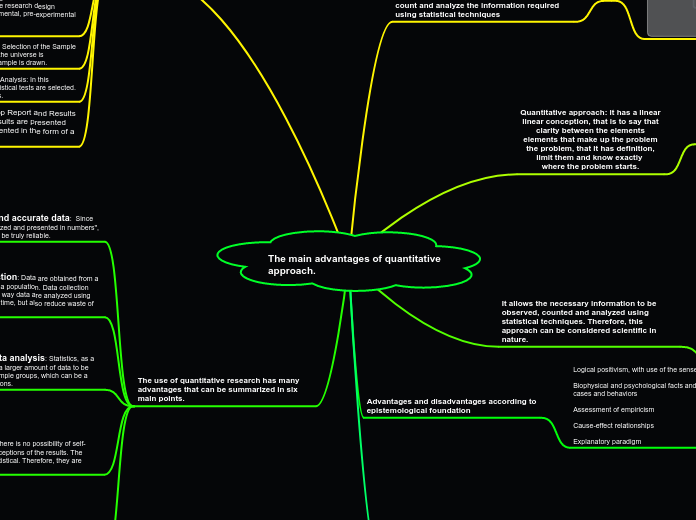The main advantages of quantitative approach.
STAGES
Phase 1- The Idea: Conceive the idea to be investigated.
research.
Phase 2- Problem Statement:
In this stage, the objectives and
objectives and research questions
research.
Phase 3-Literature Review and
Theoretical Framework Development
The literature review, detection,
and consultation of the literature.
literature.
Phase 4-Visualization of the Scope of the Study
Study Scope: Define whether the research
is initiated as exploratory, descriptive, correlational
descriptive, correlational or explanatory
explanatory and to what level it will go.
Phase 5-Elaborate Hypotheses and Define
Variables: The hypothesis is established,
the variables are detected.
Phase 6-Research Design:
Selecting the appropriate research design
research design (experimental, pre-experimental
pre-experimental or
quasi-experimental).
Phase 7-Definition and Selection of the Sample
Sample: In this stage, the universe is
the universe and the sample is drawn.
Phase 8-Data Analysis: In this
stage, the statistical tests are selected.
statistical tests.
Phase 9-Develop Report and Results
Results: The results are presented
results are presented in the form of a
research report.
The use of quantitative research has many advantages that can be summarized in six main points.
Collect reliable and accurate data: Since data is "collected, analyzed and presented in numbers", the results obtained will be truly reliable.

Rapid data collection: Data are obtained from a representative group of a population. Data collection methods, as well as the way data are analyzed using statistics, not only save time, but also reduce waste of resources.

Wide range of data analysis: Statistics, as a useful tool, also allows a larger amount of data to be obtained from larger sample groups, which can be a limitation in other situations.

Eliminates bias: There is no possibility of self-interpretation or preconceptions of the results. The results obtained are statistical. Therefore, they are verifiable.
Objective and adequate: for hypothesis testing and the results are valid, reliable and generalizable to a larger population.

Is an investigation about a specific problem through the application of a scientific approach adopted, that permits to observe, count and analyze the information required using statistical techniques

Quantitative approach: it has a linear
linear conception, that is to say that
clarity between the elements
elements that make up the problem
the problem, that it has definition,
limit them and know exactly
where the problem starts.

It allows the necessary information to be observed, counted and analyzed using statistical techniques. Therefore, this approach can be considered scientific in nature.

Advantages and disadvantages according to
epistemological foundation
Logical positivism, with use of the senses.
Biophysical and psychological facts and causes of
cases and behaviors
Assessment of empiricism
Cause-effect relationships
Explanatory paradigm
Advantages and disadvantages according to
philosophical foundations
Empiricism-Realism.
Knowledge is summarized in generalizable forms and
generalizable contexts.
An external reality is presumed to exist,
governed by immutable and mechanical laws.
mechanical.
